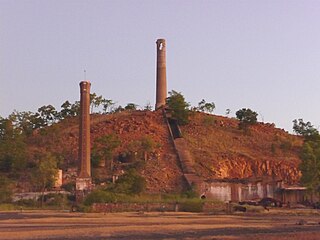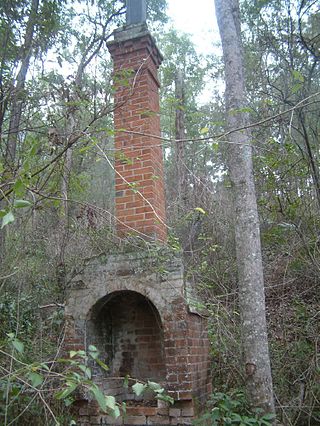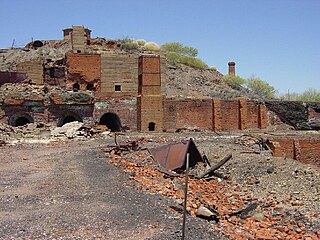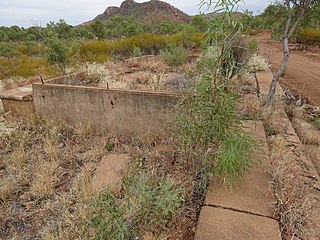
Copper extraction refers to the methods used to obtain copper from its ores. The conversion of copper ores consists of a series of physical, chemical and electrochemical processes. Methods have evolved and vary with country depending on the ore source, local environmental regulations, and other factors.
Hydrometallurgy is a technique within the field of extractive metallurgy, the obtaining of metals from their ores. Hydrometallurgy involve the use of aqueous solutions for the recovery of metals from ores, concentrates, and recycled or residual materials. Processing techniques that complement hydrometallurgy are pyrometallurgy, vapour metallurgy, and molten salt electrometallurgy. Hydrometallurgy is typically divided into three general areas:
Mount Isa Mines Limited ("MIM") operates the Mount Isa copper, lead, zinc and silver mines near Mount Isa, Queensland, Australia as part of the Glencore group of companies. For a brief period in 1980, MIM was Australia's largest company. It has pioneered several significant mining industry innovations, including the Isa Process copper refining technology, the Isasmelt smelting technology, and the IsaMill fine grinding technology, and it also commercialized the Jameson Cell column flotation technology.
Zinc smelting is the process of converting zinc concentrates into pure zinc. Zinc smelting has historically been more difficult than the smelting of other metals, e.g. iron, because in contrast, zinc has a low boiling point. At temperatures typically used for smelting metals, zinc is a gas that will escape from a furnace with the flue gas and be lost, unless specific measures are taken to prevent it.

The Chillagoe smelters is a heritage-listed refinery at Chillagoe-Mungana Caves National Park, Mareeba Mining District, Chillagoe, Shire of Mareeba, Queensland, Australia. It operated in the early 1900s. It is also known as Chillagoe State Smelters. It was added to the Queensland Heritage Register on 21 October 1992.
Mount Cuthbert is 100 kilometres north-west of Cloncurry, Queensland. It was once a copper mining town, booming in 1918, when Pugh's Almanac Queensland Directory estimated Mount Cuthbert's population at 750. It recorded six boarding houses, a hotel, a racing club and several stores in the town. Mount Cuthbert's population quickly declined mainly due to the global collapse of the copper market. Mt Cuthbert in the 1921 census had population of only 267 and by 1924 Pugh's notes that most storekeepers had left. The Railway branch line to Mount Cuthbert was closed in 1949.
Sundown Tin and Copper Mine is a heritage-listed mine at Little Sundown Creek, Stanthorpe, Southern Downs Region, Queensland, Australia. It was built from c. 1897 to 1920s. It was added to the Queensland Heritage Register on 28 July 2000.

Glassford Creek Smelter Sites are the heritage-listed remains of a former smelter at Glassford State Forest, off Many Peaks Road, Many Peaks, Gladstone Region, Queensland, Australia. It was built c. 1903. It is also known as Glassford Creek Copper Smelters. It was added to the Queensland Heritage Register on 4 July 2006.

Norton Goldfield is a heritage-listed former mine at Norton Road, near Nagoorin, Boyne Valley, Gladstone Region, Queensland, Australia. It was built from 1870s to 1941. It is also known as Milton Goldfield. It was added to the Queensland Heritage Register on 27 October 2006.

Adolphus William Copper Smelter is a heritage-listed former copper smelter and associated mining camp at Westwood and Oakey Creek in Rockhampton Region, Queensland, Australia. It was built in 1874. It was added to the Queensland Heritage Register on 13 May 2011.

Richmond Mill Ruins is a heritage-listed sugar cane mill at Habana Road, Richmond, Mackay, Mackay Region, Queensland, Australia. It was built in 1881. It is also known as Richmond Mill. It was added to the Queensland Heritage Register on 4 June 1996.

Rocky Bluff Battery and Township is a heritage-listed former mining town at Watsonville, Shire of Mareeba, Queensland, Australia. It was built from 1902 to c. 1926. It is also known as Stannary Hills Mill. It was added to the Queensland Heritage Register on 13 December 2002.

Mining works on Towers Hill is a heritage-listed group of mining ruins at Towers Hill, Charters Towers, Charters Towers Region, Queensland, Australia. They were built from 1872 to 1940s. They are individually known as Pyrites Works, Rainbow Battery, and Towers Chlorination Works. They were added to the Queensland Heritage Register on 29 April 2003.
Einasleigh Copper Mine and Smelter is a heritage-listed mine at Daintree Road, Einasleigh, Shire of Etheridge, Queensland, Australia. It was built from 1867 to 1922. It is also known as Lynd Copper Mine and New Einasleigh Copper Mine. It was added to the Queensland Heritage Register on 11 December 2006.

Mount Cuthbert Township and Smelter is a heritage-listed mining camp north-west of Kajabbi Township, Three Rivers, Shire of Cloncurry, Queensland, Australia. It was built from c. 1908 to c. 1925. It is also known as Kalkadoon Mine & Winding Plant, Mount Cuthbert Mine & Smelter, and Mount Cuthbert Township & Railway Formation. It was added to the Queensland Heritage Register on 25 May 2004.

Kuridala Township site is a heritage-listed mining camp in the locality of Kuridala, Shire of Cloncurry, Queensland, Australia. It was built from 1880s to 1920s. It is also known as Hampden Township, Hampden Smelter, Kuridala Smelter, and Friezeland Township. It was added to the Queensland Heritage Register on 12 June 2009.

Mount Elliott Mining Complex is a heritage-listed copper mine and smelter at Selwyn, Shire of Cloncurry, Queensland, Australia. It was designed by William Henry Corbould and built in 1908. It is also known as Mount Elliott Smelter and Selwyn. It was added to the Queensland Heritage Register on 16 September 2011. See also Mount Elliott Company Metallurgical Plant and Mill and Mount Elliott mine.

Mount Isa Mine Early Infrastructure is a heritage-listed group of mining infrastructure on the Mount Isa Mine Lease, Mount Isa (locality), City of Mount Isa, Queensland, Australia. They comprise the Lawlor Shaft & Winding Plant, the Urquhart Shaft and Headframe, the Mount Isa Mine Experimental Dam, and the Mount Isa Mine Power Station. They were built from 1924 to c. 1963. They were added to the Queensland Heritage Register on 25 February 2005.

Ravenswood Mining Landscape and Chinese Settlement Area is a heritage-listed former mining town and archaeological site on the reserve bounded by School Street, Cemetery Road, Railway Street and Burdekin Falls Dam Road, Ravenswood, Charters Towers Region, Queensland, Australia. It was added to the Queensland Heritage Register on 14 October 2016.

Wee MacGregor railway is a heritage-listed tramway and railway associated with the former towns of Ballara and Hightville in the locality of Kuridala, Shire of Cloncurry, Queensland, Australia. It was built from 1909 to 1926. It was added to the Queensland Heritage Register on 1 March 2019.

















